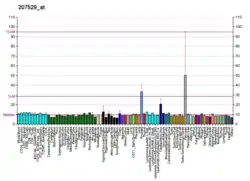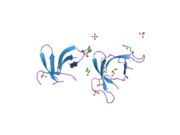DEFA5
Defensin, alpha 5 (DEFA5) also known as human alpha defensin 5 (HD5) is a human protein that is encoded by the DEFA5 gene.[3][4] DEFA5 is expressed in the Paneth cells of the ileum.[5]
Defensins are a family of microbicidal and cytotoxic peptides thought to be involved in host defense. They are abundant in the granules of neutrophils and also found in the epithelia of mucosal surfaces such as those of the intestine, respiratory tract, urinary tract, and vagina. Members of the defensin family are highly similar in protein sequence and distinguished by a conserved cysteine motif. Several of the human alpha defensin genes appear to be clustered on chromosome 8. The protein encoded by this gene, defensin, alpha 5, is highly expressed in the secretory granules of Paneth cells of the ileum.[3]
References
- ENSG00000285251 GRCh38: Ensembl release 89: ENSG00000164816, ENSG00000285251 - Ensembl, May 2017
- "Human PubMed Reference:". National Center for Biotechnology Information, U.S. National Library of Medicine.
- "Entrez Gene: DEFA5 defensin, alpha 5, Paneth cell-specific".
- Jones DE, Bevins CL (January 1993). "Defensin-6 mRNA in human Paneth cells: implications for antimicrobial peptides in host defense of the human bowel". FEBS Lett. 315 (2): 187–92. doi:10.1016/0014-5793(93)81160-2. PMID 8417977. S2CID 45099115.
- Zhao C, Wang I, Lehrer RI (24 Nov 1996). "Widespread expression of beta-defensin hBD-1 in human secretory glands and epithelial cells". FEBS Lett. 396 (2–3): 319–22. doi:10.1016/0014-5793(96)01123-4. PMID 8915011. S2CID 22367037.
Further reading
- Mallow EB, Harris A, Salzman N, et al. (1996). "Human enteric defensins. Gene structure and developmental expression". J. Biol. Chem. 271 (8): 4038–45. doi:10.1074/jbc.271.8.4038. PMID 8626737.
- Bevins CL, Jones DE, Dutra A, et al. (1996). "Human enteric defensin genes: chromosomal map position and a model for possible evolutionary relationships". Genomics. 31 (1): 95–106. doi:10.1006/geno.1996.0014. PMID 8808285.
- Porter EM, Liu L, Oren A, et al. (1997). "Localization of human intestinal defensin 5 in Paneth cell granules". Infect. Immun. 65 (6): 2389–95. doi:10.1128/IAI.65.6.2389-2395.1997. PMC 175331. PMID 9169779.
- Quayle AJ, Porter EM, Nussbaum AA, et al. (1998). "Gene expression, immunolocalization, and secretion of human defensin-5 in human female reproductive tract". Am. J. Pathol. 152 (5): 1247–58. PMC 1858596. PMID 9588893.
- Ghosh D, Porter E, Shen B, et al. (2002). "Paneth cell trypsin is the processing enzyme for human defensin-5". Nat. Immunol. 3 (6): 583–90. doi:10.1038/ni797. PMID 12021776. S2CID 22022089.
- Strausberg RL, Feingold EA, Grouse LH, et al. (2003). "Generation and initial analysis of more than 15,000 full-length human and mouse cDNA sequences". Proc. Natl. Acad. Sci. U.S.A. 99 (26): 16899–903. doi:10.1073/pnas.242603899. PMC 139241. PMID 12477932.
- Salzman NH, Ghosh D, Huttner KM, et al. (2003). "Protection against enteric salmonellosis in transgenic mice expressing a human intestinal defensin". Nature. 422 (6931): 522–6. doi:10.1038/nature01520. PMID 12660734. S2CID 1096692.
- Gerhard DS, Wagner L, Feingold EA, et al. (2004). "The status, quality, and expansion of the NIH full-length cDNA project: the Mammalian Gene Collection (MGC)". Genome Res. 14 (10B): 2121–7. doi:10.1101/gr.2596504. PMC 528928. PMID 15489334.
- Szyk A, Wu Z, Tucker K, et al. (2006). "Crystal structures of human alpha-defensins HNP4, HD5, and HD6". Protein Sci. 15 (12): 2749–60. doi:10.1110/ps.062336606. PMC 2242434. PMID 17088326.
- Wu Z, Ericksen B, Tucker K, et al. (2004). "Synthesis and characterization of human alpha-defensins 4-6". J Pept Res. 64 (3): 118–25. doi:10.1111/j.1399-3011.2004.00179.x. PMID 15317502.
- de Leeuw E, Burks SR, Li X, et al. (2007). "Structure-dependent functional properties of human defensin 5". FEBS Lett. 581 (3): 515–20. doi:10.1016/j.febslet.2006.12.036. PMC 1832120. PMID 17250830.




